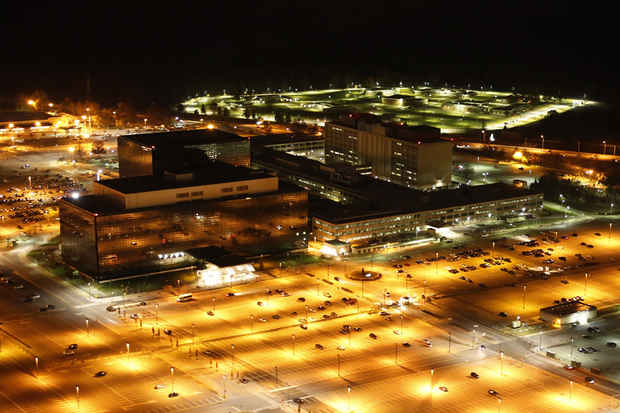“Little Sister (is watching you, too)” Exhibition
Pratt Manhattan Gallery

[Image: Trevor Paglen, aerial photograph of the National Security Agency, (2013), commissioned by Creative Time Reports.]
This event has ended.
Pratt Manhattan Gallery presents Little Sister (is watching you, too), an exhibition of 14 artworks and activist projects that look back at the apparatus of government agencies and raise questions about how data impacts decision-making, civic rights, and liberties. The exhibition addresses issues surrounding ethics, accountability, and the visual and sonic strategies involved in monitoring individuals or systems of power. Many of the projects use information from publicly available sources to ask questions about the limits of transparency and visualization and explore how data analysis is shaping political decisions and civic rights. The exhibition is curated by Christiane Paul, adjunct curator of new media arts at the Whitney Museum of American Art and associate professor in the School of Media Studies at The New School.
Featured projects include:
· “A Convention of Tiny Movements,” an audio documentary and installation by Lawrence Abu Hamdan that provides a speculative fiction about the future of surveillance. The project is based on research by MIT scientists who have discovered that the tiny vibrations caused when our voices are propelled through air and hit objects surrounding us can be extracted through a high-speed video recording of the respective objects. The project explores the implications of our “sonic footprints” and highlights objects that government agencies could potentially use as sound recording devices as well as those that technology can’t yet reach.
· Aerial photographs by Trevor Paglen, shot by night from a helicopter rented by the artist, that show three of the largest agencies in the U.S. intelligence community: the National Security Agency headquarters; the National Reconnaissance Office, which builds and operates America’s spy satellites; and the National Geospatial-Intelligence Agency. The images, which are made available to the public on Wikimedia, highlight the stark contrast between the invisibility of the agencies’ operations and the visible physicality of their buildings and data centers.
· “Citizen Ex,” a downloadable browser extension by James Bridle that helps users understand a new form of their citizenship that has emerged as they browse the Web traversing time, space, and law zones. This new citizenship stems from the National Security Agency’s (NSA) use of browsing data to assign a percentage score to people to decide whether they are protected as a U.S. citizen who can’t be surveilled by the NSA; if the score drops below 50 percent, for example, the NSA can start recording peoples’ histories.
Other participating artists include Paolo Cirio; R. Luke DuBois; Nancy Paterson and a team of professors and researchers at the University of Toronto (Andrew Clement, Colin McCann, Antonio Gamba, Jonathan Obar, David Madison, and Dawn Walker); and YoHa (Matsuko Yokokoji and Graham Harwood) with Matthew Fuller.
Media
Schedule
from December 11, 2015 to January 30, 2016
Opening Reception on 2015-12-10 from 18:00 to 20:00